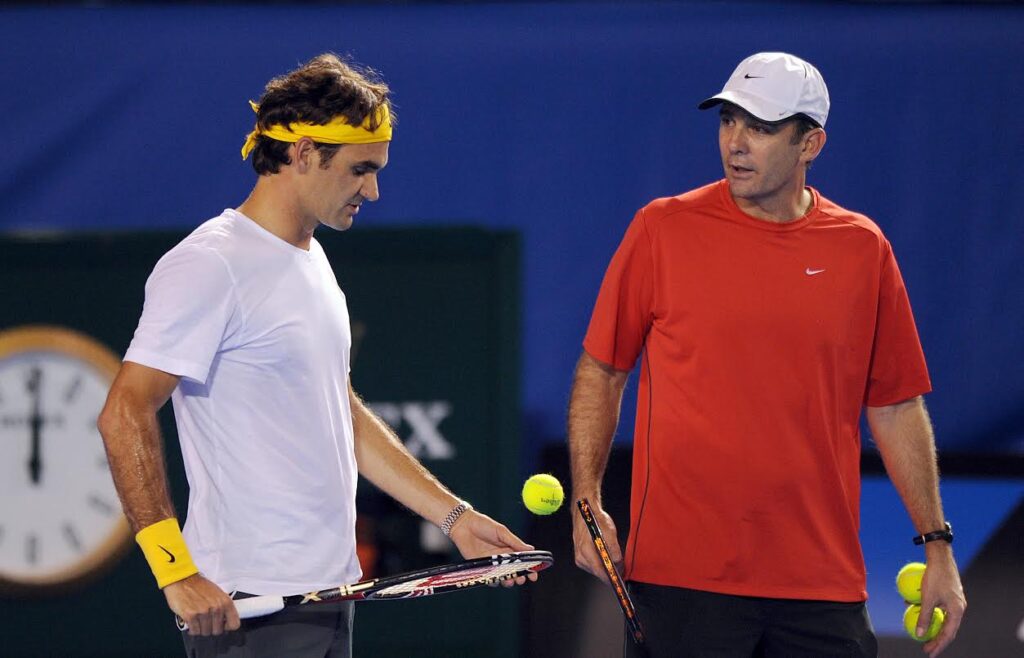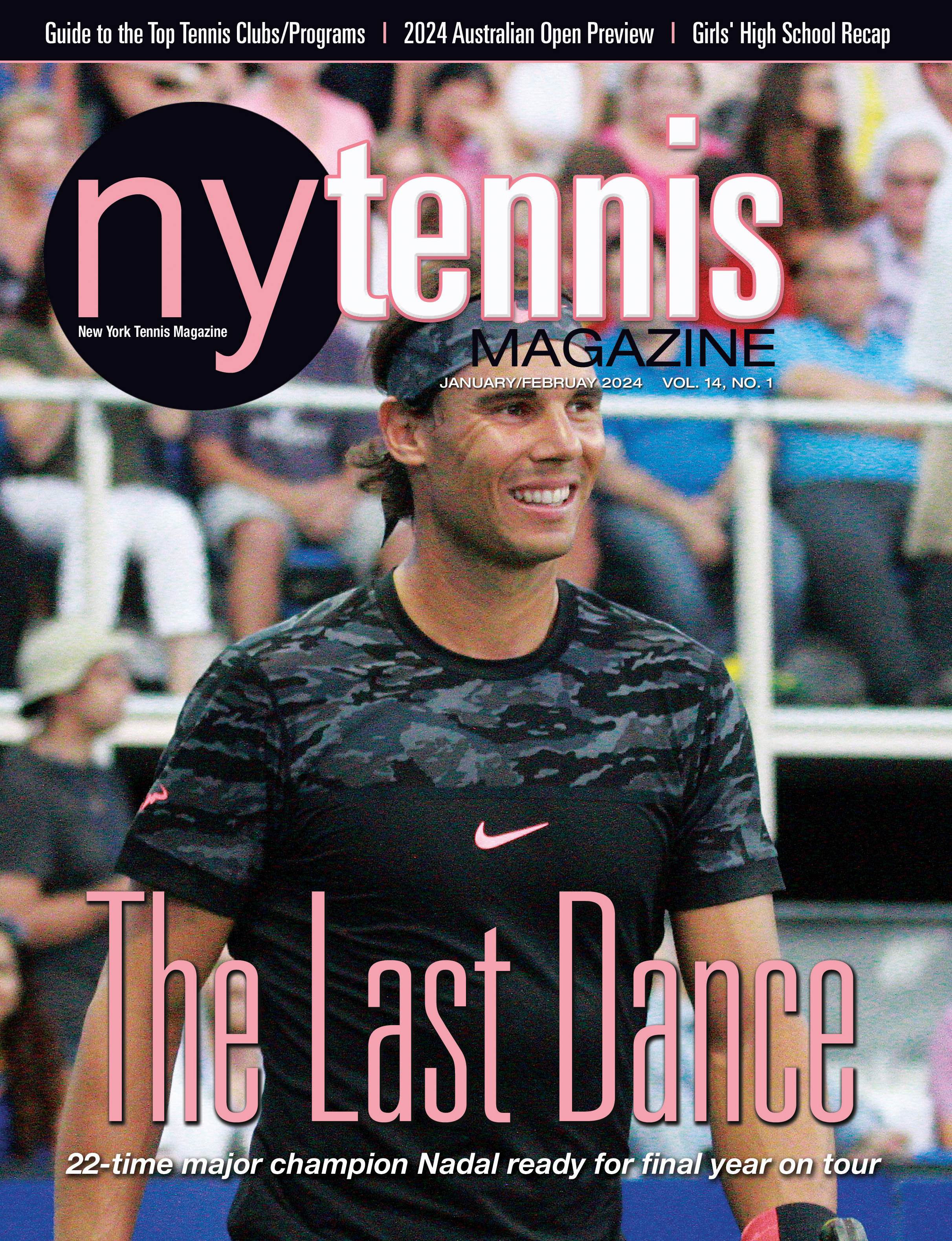At the Net With Paul Annacone

Paul Annacone was born and raised on the East End of Long Island before going on to carve out a decorated career in the sport of tennis. The Long Island native graduated from East Hampton High School before moving on to the University of Tennessee, where he would win the Intercollegiate Tennis Association (ITA) Player of the Year in 1984. That same year, Annacone would advance to the quarterfinals at Wimbledon.
Following a successful playing career, Annacone would go on to coach some of the world’s top players, most notably all-time greats Pete Sampras and Roger Federer.
Long Island Tennis Magazine recently sat down with Paul to talk about his Long Island roots, his coaching style and playing career, and much more.
Tell us about your Long Island upbringing.
I was born in Southampton and raised in East Hampton. I grew up middle-class and both of my parents were educators. I loved the lifestyle and the quality of life out there in The Hamptons. I came along in the dark ages when there really wasn’t a lot of indoor clubs, so I moved to the Nick Bollettieri Tennis Academy in Florida for about three-and-a-half years to train. But I was fortunate enough to come back and graduate with my friends at East Hampton High School. I loved growing up a Long Island kid, and I still spend a lot of time in New York and have a house out in The Hamptons.
How did you first get involved with the sport?
My parents started playing. Growing up in a middle-class home, they didn’t have a lot of extra money lying around for babysitters, so they would take my brother and I down to the public parks to play with them. When I was about six- or seven-years-old, I became pretty good and started enjoying the sport more and more. At the age of nine, I played my first Under-12 tournament, and my passion for the sport just took off from there. I always enjoyed it, and always loved the competition. I simply fell in love with the sport.
You always have to go back to your parents. I had to make some tough decisions as a kid to pursue a dream and the Bollettieri Academy in Florida was the answer. My parents were always supportive and gave me the opportunity to pursue my dream.
 When did you have the moment of realization that you could play on the pro tour?
When did you have the moment of realization that you could play on the pro tour?
I went to the University of Tennessee and my tennis career really began to take off, especially in my junior year when I made a really big jump. I had a great season, finishing as the number one collegiate player and went from the ranks of NCAA tennis to playing at Wimbledon. I ended up going to the quarterfinals at Wimbledon, and that was my introduction to the pro circuit.
In that junior year of college in 1984, I went from being a good college player to winning three qualifying rounds and four main draw rounds at Wimbledon. I ended up playing my childhood idol, Jimmy Connors, in the quarterfinals. He gave me a pretty good tennis lesson (6-2, 6-4, 6-2), but that’s when I realized I could compete on the professional level. Coming from that small-town mentality, it took me a while to grasp that, but that was a very big moment for me.
When you were playing, did you ever think that coaching would be in your future?
I always thought that I was a pretty expansive thinker. I tried to learn more beyond just what I needed to do, and sometimes, in an individual sport, that can be a challenge. As I went through my career, I tried to be a sponge as often as possible. I helped a few players I knew on the tour informally, and I saw my athletic mortality coming as I had foot surgery, elbow surgery and ultimately, a herniated disc. I was interested in the game and helping other players, so that’s when the coaching aspect really started to intrigue me.
How did your coaching relationship with Pete Sampras come about?
I was fortunate to be put into an unfortunate situation. I knew Pete was a young kid on tour, and he traveled with his brother, just like I did with my brother, Steve, and we got to be friends. A few years later, his coach, Tim Gullikson, became very sick and I was asked to help Pete and try to make some good of a bad situation. My timeline as a player was winding down, so the timing worked out well. Tim was unbelievably gracious in helping me help Pete, and I was able to build a rapport with Pete. After Tim unfortunately lost his battle with cancer, I became Pete’s full-time coach.
You would go on to coach another all-time great in Roger Federer. What similarities and what differences did you find between the two?
Roger and Pete are two very different people. Both have similar goals of being as successful as possible, but did so in different ways. Roger is much more extroverted. He loves life and enjoys being a global citizen. He embraces the global environment and what comes from being an international superstar, whereas Pete was much more introverted and liked a small, controlled environment. All that mattered to Pete was being humble, professional and winning as many Grand Slams as he could.
We had to use different tools to get the same message across. The most successful coaches are the ones who can get their message across to different personalities. It’s a great challenge, but also a fun one.
Roger could sit around at great length talking about tennis. He liked watching a lot of film and could talk about different ways to get things accomplished, absorb a lot of information, and still go out and be super-focused. With Pete, he needed things much more clear and concise. We would go over four or five bullet points and then move on. He didn’t want a lot of extraneous conversation that could cloud his mission. The point was to get your message across to him in a clear and simplistic manner, then evaluate it afterwards and move on.
As great of tennis players as they were and are, they were better people. That really helped me feel comfortable in dealing with people despite how successful they may be.
 You spent time as the head of USTA Player Development. How would you evaluate the current state of American tennis?
You spent time as the head of USTA Player Development. How would you evaluate the current state of American tennis?
Tennis has become such a global game, and I think in the U.S., we lose a lot of our best athletes to other sports, such as baseball, basketball and football. It’s much more convenient and simple to play those sports in high school, and it makes tennis a bit more of an isolated sport.
In the long-term, I think player development in the U.S. is more about focusing on participation numbers than development. The Player Development staff do a terrific job with their players, but the more people who play, the more likely you are going to have a deeper talent pool to work with. That being said, I think Patrick McEnroe did a terrific job in his role as head of USTA Player Development over the last decade, just look at the current number of players on the pro tour who are progressing in both the men’s and women’s games.
At the end of last year, there were approximately 14 American women in the top 100, with Serena obviously carrying the torch, but players like Madison Keys and Sloane Stephens are knocking on the door.
On the men’s side, 10 U.S. players ages 20 or younger are currently inside the top 500. It may not sound like a lot but it’s significant. A lot of youngsters are starting their career arc as teenagers and that’s a great sign.
Because the game has become so physical, I’d be shocked to see a teenager win a Grand Slam, but I do think we will see more players like Taylor Fritz, Jared Donaldson and Frances Tiafoe break into the top 50 quickly.
On both the men’s and women’s tour, we’re going to have more players in the top 50 coming soon, and I think the signs are terrific right now.
You recently partnered with Oasis Day Camps. How did that partnership come about and what are the goals of the partnership?
Oasis Day Camps reached out to me, and after they did, I read about them and started to learn what they had started back in 2000. The Oasis-Gold Coast partnership is one that really resonates with me. As a small-town, New York kid, it really hit close to home. The foundation of what they are trying to do is community-oriented and to give kids an opportunity to learn life lessons through sports. I think the processes, lessons and discipline you learn in tennis can help you no matter what you do in life, and it’s rewarding to be able to come back to the Tri-State Area where I grew up and help kids pursue their dreams and goals.
Will you be on-site at the camps to coach tennis?
Absolutely, and that was a big part of the initial conversation. As excited as I was, I wasn’t going to do it if I wasn’t going to be there. I didn’t want to lend my name to it and just be there once. That’s not the goal. Clearly, I have a pretty full plate, but we have put together a nice blueprint so that I can have a significant impact on the campers, and also help the coaches teach the philosophy that I believe in.
I want to be there to have an impact. Another piece of good news is that my brother Steve’s company, Annacone Tennis Management, will have a hands-on role and Steve will be the point person to push my philosophy and message when I am not there. Steve and I are going to educate the coaches who will be there every day about the message we want to get across. That way, the coaches are teaching the philosophies we have passed on, and the kids have the repetition, format and environment they need to succeed. We are very excited about this opportunity.







